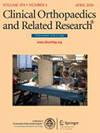Should We Always Use a Metaphyseal Cone in Conjunction With Tibial Augments for Uncontained Defects? A Finite-element Biomechanical Analysis.
IF 4.4
2区 医学
Q1 ORTHOPEDICS
引用次数: 0
Abstract
BACKGROUND Choosing the appropriate implants for reconstruction in revision TKA is essential for long-term fixation. While cones and augments are routinely utilized to address tibial defects, the effect of augment location and size on the biomechanical stability of revision TKA constructs and the indications for the use of metaphyseal cones are not known. QUESTIONS/PURPOSES Is the risk of cement-implant debonding of revision TKA constructs impacted by the thickness and location (medial versus bicompartmental) of tibial augments and the presence of metaphyseal cones during (1) a demanding daily activity like stair ascent and (2) torsional loads? METHODS Under institutional review board approval, we developed patient-specific finite-element models of revision TKA from four patients (three males and one female, ages 50 to 80 years, BMI 27 to 37 kg/m2) who underwent two-stage revision and had a CT scan with no metal artifact after first-stage implant removal. For each patient, we created 5-mm, 10-mm, and 15-mm-thick medial and bicompartmental uncontained defects. We considered two situations for the metaphysis: using a metaphyseal cementless cone into which the implant was cemented or using only cement to fill the metaphyseal cavity. To answer our first question, we conducted finite-element simulations of the immediate postoperative loading scenario representative of stair ascent, while to answer our second research question, we considered an idealized torsional test consisting of 100 N of axial load and twice the axial moment experienced at the same instant of stair ascent. We calculated the risk of cement-implant debonding from an interfacial failure function (calculated as a function of the normal and shear stresses at the cement-implant interface) wherein values of interfacial failure ≥ 1 indicate debonding. Our primary outcome was the cement-implant interface area with ≥ 10% risk of debonding, which we considered to be the interface area with greater than minimal risk of debonding. RESULTS During stair ascent, we computed a decrease of the cement-implant interface area with greater than minimal risk of debonding (that is, ≥ 10% risk of debonding) with medial uncontained defects (median [IQR] 2.6% [1.4% to 3.7%] with 15-mm augment) but not with bicompartmental defects (5.2% [3.7% to 5.3%]) compared with the scenario with no uncontained defect (5.2% [3.9% to 5.9%]). Compared with using a metaphyseal cone, using cement alone in the metaphysis increased the interfacial area with greater than minimal risk of debonding, reaching a median (IQR) of 13.8% (11.4% to 14.3%) with a 15-mm bicompartmental defect. Under the torsional load scenario, the increase in the area with greater than minimal risk of debonding was small for medial defects, from a median (IQR) of 4.3% (2.5% to 5.3%) to 4.9% (3.9% to 6.2%) when using a metaphyseal cone and from 7.0% (4.0% to 9.5%) to 7.2% (6.1% to 9.8%) when only using cement in the metaphysis. However, the area at risk of failure of bicompartmental defects under torsional loads reached 23% when using a metaphyseal cone and 52% when using only cement in the metaphysis. CONCLUSION The size of bicompartmental uncontained defects treated with a bicompartmental augment (a full block) negatively affected the overall construct stability in our finite-element model. However, medial defects of the same size did not negatively influence the stability of the construct when addressed with an augment perfectly contacting the bone. In our computational finite-element model, using metaphyseal cones increased the stability of the revision TKA construct. CLINICAL RELEVANCE Our finite-element results suggest that medial augments have little impact on the stability of revision TKA constructs, but clinicians may want to combine bicompartmental augments with cones for increased stability of revision TKA constructs.对于无法控制的缺损,我们是否应该总是使用干骺端椎体联合胫骨增强物?有限元生物力学分析。
背景:选择合适的种植体重建翻修TKA对于长期固定至关重要。虽然椎体和增强物通常用于治疗胫骨缺损,但增强物的位置和大小对TKA修复装置生物力学稳定性的影响以及使用干骺端椎体的适应症尚不清楚。问题/目的:在(1)高要求的日常活动(如爬楼梯)和(2)扭转载荷期间,胫骨增强物的厚度和位置(内侧与双室)以及干骺端锥的存在是否会影响翻修TKA结构的骨水泥-植入物脱粘的风险?方法:在机构审查委员会的批准下,我们建立了4例患者翻修TKA的特定患者有限元模型(3男1女,年龄50至80岁,BMI 27至37 kg/m2),他们接受了两期翻修,并在第一期种植体移除后进行了CT扫描,没有金属伪影。对于每位患者,我们分别制造了5mm、10mm和15mm厚的内侧和双室不含缺损。我们考虑了干骺端的两种情况:使用无骨水泥的椎体植入骨水泥或仅使用骨水泥填充干骺端腔。为了回答我们的第一个问题,我们进行了具有代表性的术后立即加载场景的有限元模拟,而为了回答我们的第二个研究问题,我们考虑了一个理想化的扭转试验,该试验包括100 N的轴向载荷和两倍于上楼时所经历的轴向弯矩。我们通过界面破坏函数(作为水泥-种植体界面的正应力和剪应力的函数计算)计算了水泥-种植体脱粘的风险,其中界面破坏值≥1表示脱粘。我们的主要结果是骨水泥-种植体界面区域脱粘风险≥10%,我们认为这是脱粘风险大于最小的界面区域。结果在楼梯上升过程中,我们计算了骨水泥-种植体界面面积的减少,与无骨水泥缺陷的情况相比,内侧无骨水泥缺陷的脱粘风险大于最小(即脱粘风险≥10%)(中位数[IQR] 2.6%[1.4%至3.7%],增加15毫米),而双腔缺损的情况下(5.2%[3.7%至5.3%]),与无骨水泥缺陷的情况(5.2%[3.9%至5.9%])。与使用干骺端锥相比,在干骺端单独使用水泥增加了界面面积,脱粘风险大于最小,对于15毫米的双腔缺损,中位(IQR)达到13.8%(11.4%至14.3%)。在扭转载荷情况下,内侧缺损的脱粘风险大于最小的面积增加很小,当使用干骺端椎体时,中位数(IQR)从4.3%(2.5%至5.3%)增加到4.9%(3.9%至6.2%),当仅在干骺端使用水泥时,中位数(IQR)从7.0%(4.0%至9.5%)增加到7.2%(6.1%至9.8%)。然而,当使用干骺端椎体时,双室缺损在扭转载荷下失败的风险面积达到23%,而当仅在干骺端使用水泥时,这一风险面积达到52%。结论双室增强(全块)处理的双室不含缺陷的大小对我们的有限元模型的整体构建稳定性有负面影响。然而,同样大小的内侧缺损在与骨完美接触的增强物处理时不会对结构的稳定性产生负面影响。在我们的计算有限元模型中,使用干骺端锥增加了修正TKA结构的稳定性。临床相关性:我们的有限元结果表明,内侧增强装置对改良TKA结构的稳定性影响不大,但临床医生可能希望将双室增强装置与锥体结合使用,以增加改良TKA结构的稳定性。
本文章由计算机程序翻译,如有差异,请以英文原文为准。
求助全文
约1分钟内获得全文
求助全文
来源期刊
CiteScore
7.00
自引率
11.90%
发文量
722
审稿时长
2.5 months
期刊介绍:
Clinical Orthopaedics and Related Research® is a leading peer-reviewed journal devoted to the dissemination of new and important orthopaedic knowledge.
CORR® brings readers the latest clinical and basic research, along with columns, commentaries, and interviews with authors.

 求助内容:
求助内容: 应助结果提醒方式:
应助结果提醒方式:


